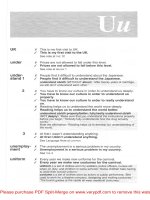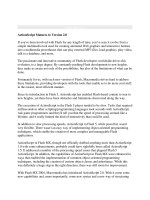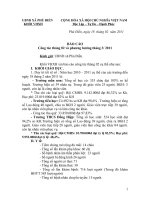lesson planning- version 2- 08-09 doc
Bạn đang xem bản rút gọn của tài liệu. Xem và tải ngay bản đầy đủ của tài liệu tại đây (87.62 KB, 20 trang )
LESSON PLANNING
LESSON 2
Contents
•
Components of a lesson plan
•
Principles for writing an effective
lesson plan
•
The criteria for evaluating the
effectiveness of a lesson plan
Questions for discussion
•
1. What is a lesson plan?
•
2. Why do we need a lesson plan?
•
3. When can we go without a lesson plan?
•
4. Can we have the same lesson plan for different classes?
•
5. What are the main components of a lesson plan?
•
6. Why and how should we allow for flexibility in a lesson
plan?
•
7. Why and how should we use ready-made lesson plans?
•
A lesson plan is the detailed plan of a lesson
with its aims, content, activities, teaching
aids, and time allocation for a particular
group of learners, prepared by the teacher
before the actual teaching
Why do we need a lesson plan?
•
Planning gives Ts the opportunity to predict
possible problems and therefore consider
solutions
•
Planning helps make sure that lesson is
balanced and appropriate for class
•
Planning gives Ts confidence
•
Planning is generally good practice and a
sign of professionalism
•
Add your reasons: …
What makes
good planning?
3 MAIN things T needs to consider before
going into the class to teach a lesson:
•
The AIM of the lesson
•
The CONTENT of the lesson (i.e. what LANGUAGE
is taught and SKILLS are practiced in the lesson)
•
The PROCEDURE of the lesson (i.e. what are the
main STAGES and what to DO at each stage)
Besides, T also needs to allow for FLEXIBILITY and
VARIETY
Aims of the lesson
When do you
When does your
friend
get up?
eat breakfast?
go to school?
finish school?
go to bed?
sleep?
In the morning
In the afternoon
In the evening
At night
When do you clean your teeth?
meet your friends?
play games?
learn English?
“What are you going to teach today”?
•
Teacher A: “We’re doing Lesson 15. It’s question
and answer practice using a substitution .”
•
Teacher B: “We’re going to practice present simple
questions with “When …” and time expression.”
•
Teacher C: “We’re going to practice asking and
answering questions using the present simple, so
that Ss learn to talk about everyday activities and
when they do them.”
Contents of the lesson
Language (vocabulary and structures):
Qs to ask:
•
What new words are introduced?
•
Which are most important?
•
What new structures are there?
•
What other structures are practiced?
Skills: Qs to ask:
•
What skills are developed in the lesson?
•
Which is practiced most?
(If possible, the lesson should include practice of
MORE THAN ONE skill)
Stages of a “what” lesson
1. Presentation: T presents new words/ structures,
gives examples, writes them on the board, etc.
2. Practice: Ss practice using words/ structures in a
controlled way (e.g. making sentences from
prompts). Practice can be oral or written.
3. Production: Ss use language they’ve learnt to
express themselves more freely (e.g. talk/ write
about their own lives and interests, to express
opinions, etc.). Production can also be oral or
written.
Stages of a “how” lesson
•
Pre-stage: T elicits vocabulary related to the topic
and pre-teaches new vocabulary and new structures
if appropriate. T elicits answers about the topics.
•
While-stage: Ss do tasks
•
Post-stage: Ss summarize the topic in the written or
spoken form, or discuss the topic further, or discuss
another related topic. Ss might also practice the new
grammar and vocabulary further
Can you identify the stages of the following
lesson?
“Well, first we talked a bit about deserts, and what’s
like to travel across a desert. Then we read a text
about an explorer who’s crossed every desert in the
world, and Ss answered Qs on it. In the text, there
were several examples of the present perfect tense.
I wrote some on the board, and I gave a few more
examples orally. Then we did a grammar exercise in
the textbook. After that, I asked Ss to make up their
own Qs using “have you ever …”? to ask each
other”
Flexibility:
•
Why? Things don’t go as planned in most lessons
•
How? (1) Build in some extra and alternative tasks and
exercises; (2) Branch away from the plan when necessary
Variety:
•
Why? (1) To get and keep Ss engaged and interested; (2)
To cater for individual differences
•
How? Vary your techniques, materials, and activities
Components of a lesson plan
•
Level, class or date for reference purposes
•
Overall time for the lesson
•
Aims
•
Teaching Aids
•
Anticipated problems
•
Procedure of lesson (stages, time allocation,
activities, techniques, interaction types, etc.)
•
Comment/ Evaluation (can be added for
future reference)
Your checklist when writing a lesson plan
•
Do I have a clear aim? Is this aim valid in
terms of my learners’ needs?
•
Can this aim be realistically achieved with
the particular group of learners I’m going to
teach in the time allowed?
•
Do the activities designed for the lesson
match and help to achieve this aim?
•
Are the activities sequenced logically
enough?
Your checklist when writing a lesson plan
•
Is there sufficient variety in techniques,
activities, and materials used?
•
Is the lesson as a whole adequately
paced and appropriately timed?
•
Is there enough learner talk?
•
Do I allow for flexibility (e.g. have
backup activities, be ready to go with
the flow, etc.)
“There’s no ‘correct’ way to write a
lesson plan, although a good lesson
plan should give a clear picture of what
T intends to do in the lesson”
(Doff, 1988, p. 101)
Adapting ready-made lesson plans
•
Why? To suit your Ss
•
How? Think about these Qs:
–
How do the techniques, activities, and
materials suit my Ss?
–
What to add, change, replace, and/ or
leave out?
Thank you for
your attention!









